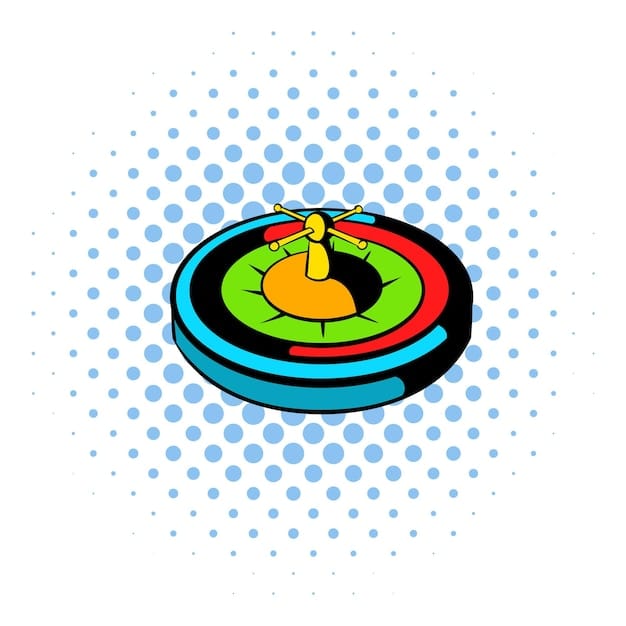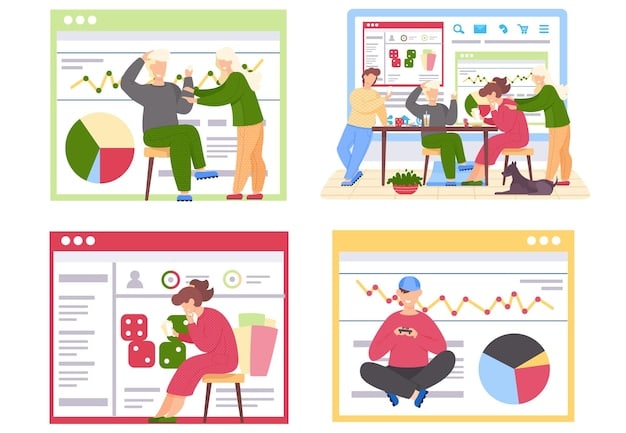Game Marketing Basics: Promote Your Game & Reach Audience

Effective game marketing is crucial for visibility and success, encompassing strategic planning from concept to post-launch to connect games with their intended audience, fostering community, and driving sales in a competitive market.
In the expansive and highly competitive world of digital entertainment, understanding Game Marketing Basics: Promote Your Game and Reach Your Target Audience is not merely an advantage; it is an absolute necessity. Launching a game without a robust marketing strategy is akin to baking a masterpiece cake and leaving it unannounced in a dimly lit pantry – no one will ever find or taste it.
Understanding the game marketing landscape
The gaming industry is a dynamic ecosystem, constantly evolving with new technologies, platforms, and player expectations. To effectively market your game, you first need to comprehend this landscape, identifying trends, understanding player behavior, and recognizing where your game fits within this intricate tapestry.
Navigating this environment requires a blend of creativity, data analysis, and strategic foresight. It’s about more than just announcing your game; it’s about crafting a narrative, building anticipation, and fostering a community around your creation long before it even hits the market.
The multi-faceted gaming market
The gaming market today is segmented, spanning various platforms from PC and consoles to mobile and VR. Each segment boasts its own unique audience demographics, preferred marketing channels, and consumption habits. A strategy that works for a mobile puzzle game might be entirely ineffective for a AAA console RPG.
- Player Demographics: Understanding who plays what, where, and why is foundational. Are they casual players, hardcore enthusiasts, or somewhere in between?
- Platform Disparities: Marketing on Steam differs significantly from marketing on the App Store or PlayStation Store. Each platform has its own discovery features, promotional tools, and community interfaces.
- Genre Nuances: Different game genres attract distinct player bases with specific interests and expectations. A horror game’s audience will respond to different emotional triggers compared to a simulation game’s audience.
Moreover, the concept of “discoverability” is paramount. With thousands of games released annually, standing out from the crowd is a monumental challenge. This necessitates a proactive and persistent marketing effort that begins early in the development cycle and continues long after launch.
Effective market research plays a pivotal role here. Before you even finalize your game’s core mechanics or art style, gathering data on competing titles, player preferences, and market gaps can inform not just your marketing strategy but also the very design of your game. This ensures that your efforts are directed towards an audience that genuinely exists and is ready to engage with your unique offering.
Defining your target audience and unique selling proposition
Before you can effectively promote your game, you must first answer two critical questions: “Who is this game for?” and “What makes this game uniquely appealing to them?” These questions lead you to define your target audience and your game’s unique selling proposition (USP).
A clear understanding of these elements acts as your compass, guiding every marketing decision from visual assets to promotional copy, ensuring that your message resonates with the right people.
Identifying your ideal player
Creating a detailed player persona goes beyond basic demographics. It involves understanding their gaming habits, interests, motivations, spending patterns, and even their preferred social media platforms. Are they competitive players seeking challenging esports experiences, or do they prefer narrative-driven single-player adventures?
- Demographics: Age, gender, location, income level.
- Psychographics: Interests, values, lifestyle, personality traits.
- Gaming Habits: Preferred genres, platforms, playtimes, motivations for playing.
This deep dive allows you to tailor your marketing message so precisely that it feels as if you’re speaking directly to each potential player. For instance, if your game appeals to players who enjoy intricate strategy and resource management, your marketing should highlight those complex systems, rather than focusing on action sequences.
Similarly, understanding where your target audience spends their time online is crucial for channel selection. If they frequent specific gaming forums, subreddits, or streaming platforms, then those are the spaces where your marketing efforts should be concentrated.
Crafting your game’s unique selling proposition (USP)
Your USP is what sets your game apart from the competition. It’s the core message that explains why players should choose your game over the thousands of others available. It could be an innovative mechanic, a compelling narrative, a unique art style, a strong multiplayer component, or a specific niche genre combination.
A strong USP is concise, memorable, and immediately communicates value. It’s often intertwined with the game’s core identity and should be front and center in all marketing materials.
Consider the competitive landscape. What are other games in your genre doing well? Where do they fall short? Your USP often emerges from filling a gap or offering a superior experience in a particular aspect. This isn’t about claiming your game is “the best”; it’s about articulating what makes it distinct and desirable to your specific audience.
Iteratively refining your USP throughout development can be beneficial. As your game evolves, new strengths might emerge, or existing ones might become more pronounced, allowing you to sharpen your marketing focus continually.
Pre-launch marketing strategies: building hype and buzz
The period leading up to your game’s launch is critical for building momentum. Pre-launch marketing is about generating anticipation, creating a community, and ensuring that when your game does hit the market, it lands with an eager and informed audience.
This phase is not a sprint but a marathon, requiring consistent effort and strategic deployment of various tools to cultivate curiosity and establish early connections with potential players.
Leveraging social media and community building
Social media platforms are indispensable for direct communication with your audience. This isn’t just about posting updates; it’s about fostering genuine engagement, listening to feedback, and building a loyal community around your game.
- Consistent Content: Share development diaries, concept art, gameplay snippets, and Q&A sessions. Show your game’s personality.
- Active Engagement: Respond to comments, participate in discussions, run polls, and create opportunities for player interaction. Make your community feel heard and valued.
- Platform Selection: Focus your efforts on platforms where your target audience is most active (e.g., Twitter, Discord, TikTok, Reddit, Instagram).
Discord, in particular, has become a cornerstone for game communities, offering real-time interaction, structured channels for different topics, and direct communication with developers. Establishing an active Discord server early on can transform passive followers into passionate advocates.
Beyond traditional social media, consider platforms like Twitch and YouTube. Collaborating with content creators or establishing your own streaming presence can expose your game to a vast and engaged audience who are actively looking for new titles to play.
Press outreach and influencer marketing
Securing coverage from gaming press and collaborating with influencers can significantly amplify your message. These avenues provide credibility and reach audiences that might be difficult to access through organic social media alone.
Craft a compelling press kit with eye-catching visuals, a concise game description, and relevant contact information. Identify journalists and media outlets whose content aligns with your game’s genre and target audience.
Influencer marketing involves partnering with streamers, YouTubers, or social media personalities whose audience matches your game’s demographic. This can range from sponsored content to providing early access keys for reviews or playthroughs.
When approaching influencers, research their content style and audience demographics to ensure a good fit. A genuine connection with an influencer can be far more effective than a forced, transactional partnership.
Sending out review codes well in advance of launch day allows media outlets and influencers sufficient time to create high-quality content. Positive early reviews or enthusiastic influencer coverage can create a powerful wave of pre-launch buzz, driving wishlists and early sales.

Launch day and post-launch marketing strategies
Launch day isn’t the finish line; it’s the starting gun for the next phase of your marketing journey. Post-launch strategies are crucial for maintaining momentum, reaching new players, and extending your game’s lifespan in a crowded market.
A well-executed launch capitalizes on pre-release hype, but sustained success depends on continuous engagement and adaptation to player feedback and market changes.
Maximizing visibility on launch day
On launch day, your primary goal is to ensure maximum visibility and encourage initial sales. This involves coordinating all your pre-launch efforts to culminate in a unified push.
- Press Release Distribution: Send out a final press release announcing the game’s availability.
- Social Media Blitz: Flood your channels with launch announcements, gameplay trailers, and direct links to purchase.
- Featured Store Presence: Work with platform holders (Steam, PlayStation, Xbox, Nintendo, App Store, Google Play) to secure featuring or prominent placement on their respective storefronts. This is often based on pre-launch wishlist numbers and the perceived quality of your game.
Early sales and positive reviews immediately after launch are vital for algorithmic visibility on digital storefronts. Encourage your early players to leave reviews, as these significantly influence potential buyers and platform algorithms. A strong initial performance can create a positive feedback loop, leading to more organic discovery.
Consider running launch discounts or bundles to incentivize early purchases, particularly if your target audience is price-sensitive. However, be mindful of industry norms to avoid devaluing your product prematurely.
Post-launch engagement and content updates
The journey of a game doesn’t end at launch; for many titles, it’s just the beginning. Post-launch marketing focuses on retaining existing players, attracting new ones, and building a sustainable future for your game.
This often involves a commitment to ongoing content updates, bug fixes, and community management. Players expect games to evolve, and providing regular updates keeps your game fresh and relevant.
Regular content updates, such as new levels, characters, features, or seasonal events, can re-engage lapsed players and attract new ones through word-of-mouth or renewed press coverage. Each update provides a new opportunity to market your game.
Community management remains critical. Respond to player feedback, address issues promptly, and foster a positive environment. A happy community is your best marketing tool.
Leverage sales periods, holidays, and gaming events to run promotions, bundles, or participate in sales. These events can provide significant boosts in visibility and sales, long after your initial launch.
Exploring new platforms or localizing your game for new regions can open up entirely new markets. This requires ongoing market research and a willingness to adapt your marketing message for different cultural contexts.
Success in post-launch marketing is about nurturing your game as a living product, continuously providing value to players, and adapting your strategy to a constantly changing landscape. It’s about building a legacy, not just a launch.
Analyzing marketing performance and adapting strategies
Marketing is not a “set it and forget it” endeavor. To ensure long-term success, it’s imperative to continually analyze your marketing performance, understand what’s working and what isn’t, and adapt your strategies accordingly. This analytical approach transforms marketing from an art into a data-driven science.
Ignoring performance metrics is akin to flying blind; you might be expending resources on ineffective channels while missing opportunities elsewhere. Robust analysis allows for optimization and a higher return on investment.
Key performance indicators (KPIs) in game marketing
Various metrics can help you assess the effectiveness of your marketing efforts. Identifying and tracking the right Key Performance Indicators (KPIs) provides valuable insights into player acquisition, engagement, and monetization.
- Wishlist Numbers: For PC and console games, high wishlist counts indicate strong pre-release interest and can influence platform featuring.
- Conversion Rates: The percentage of page visitors who actually purchase or download your game.
- User Acquisition Costs (UAC): How much it costs to acquire a new player through paid advertising.
- Retention Rates: How many players continue to play your game over time. This is especially critical for games with long-term monetization strategies.
- Engagement Metrics: Time spent in-game, daily active users (DAU), monthly active users (MAU), average session duration.
- Social Media Reach and Engagement: Likes, shares, comments, followers, impressions on your social media posts.
- Media Mentions and Sentiment: How often your game is mentioned in the press or by influencers, and whether the sentiment is positive or negative.
These KPIs should be regularly reviewed, often on a weekly or monthly basis, to identify trends and anomalies. A sudden drop in conversion rates might indicate an issue with your store page, while a surge in social media engagement could point to a successful content update.
Tools for tracking these metrics range from built-in analytics on digital storefronts (Steamworks, App Store Connect) to third-party marketing automation platforms and social media analytics tools. Consolidating this data into clear, actionable reports is essential for making informed decisions.
Iterative optimization and A/B testing
Once you’ve identified which aspects of your marketing are underperforming, the next step is to iterate and optimize. This often involves making small, controlled changes and measuring their impact. A prime example is A/B testing.
A/B testing involves creating two versions of a marketing asset (e.g., a store page description, an ad creative, a trailer thumbnail) and showing them to different segments of your audience to see which performs better. This data-driven approach removes guesswork and allows you to refine your materials for maximum impact.
For instance, you might A/B test different taglines on your Steam page to see which one leads to more wishlists. Or you could test two different ad creatives on a social media platform to determine which generates a lower UAC.
Beyond A/B testing, be prepared to completely overhaul strategies if they consistently fail to meet objectives. The marketing landscape is constantly shifting, and what worked last year might not work today. Staying agile and receptive to change is a hallmark of successful game marketing.
Regularly solicit feedback from your community as well. While quantitative data is crucial, qualitative insights from your players can provide context and uncover issues or opportunities that metrics alone might miss. This holistic approach ensures that your marketing efforts are not only data-driven but also deeply connected to the player experience.

Common marketing pitfalls to avoid
Even with the best intentions and a solid strategy, game marketing is fraught with potential pitfalls. Awareness of these common mistakes can help developers steer clear of costly errors and maximize the impact of their promotional efforts.
Avoiding these traps is as important as implementing effective strategies, as a single misstep can undermine months of hard work and significant investment.
Underestimating the marketing budget and timeline
One of the most common mistakes is underestimating the resources required for effective marketing. Marketing is not an afterthought; it requires a dedicated budget and a timeline that spans the entire development cycle and beyond.
Many developers pour all their resources into game development, leaving little to no budget for marketing. This often results in a fantastic game that nobody knows about. Marketing costs can range from 10% to 50% or even more of your total development budget, depending on your ambitions and target audience.
- Insufficient Budget: Without adequate funds, your reach will be limited, and you won’t be able to compete effectively in crowded markets.
- Late Start: Marketing efforts that begin only a few weeks before launch miss out on valuable time to build hype and a community.
- Ignoring Post-Launch: Believing marketing ends at launch is a huge mistake. Ongoing marketing is vital for long-term success and sustainability.
Plan your marketing budget as part of your initial game development budget. Allocate funds for advertising, community management tools, press kit creation, attendance at industry events, and potential influencer collaborations.
Start marketing early. Even abstract concepts or early prototypes can be used to generate interest and gather feedback. This early engagement can inform development and build a core audience.
Ignoring community feedback and negative criticism
In the digital age, ignoring your community is a recipe for disaster. Players are vocal, and their feedback, both positive and negative, is a goldmine of information and an opportunity to build stronger relationships.
Dismissing negative criticism or failing to address community concerns can quickly erode trust and damage your reputation. A single poorly handled customer service interaction can lead to a viral negative impression.
Instead, embrace feedback. Respond thoughtfully to comments, acknowledge issues, and communicate clearly about how you plan to address them. Even if you can’t implement every suggestion, showing that you’re listening goes a long way.
Negative reviews or criticisms, while sometimes painful, offer invaluable insights into what aspects of your game or marketing might be misaligned with player expectations. Use them as learning opportunities to refine both your product and your messaging.
Building a strong, positive relationship with your community can transform them into your most ardent advocates. They will share your game, defend it against unfair criticism, and provide invaluable testing and feedback, becoming an extension of your marketing team without even realizing it.
Leveraging analytics and data for growth
In the evolving landscape of game marketing, intuition and creativity alone are rarely sufficient. To truly thrive, developers must embrace analytics and data-driven insights. This strategic use of information enables precise targeting, optimizes resource allocation, and fosters continuous growth.
Understanding the numbers behind player behavior and campaign performance provides a critical edge, allowing for proactive adjustments that can significantly impact a game’s success.
Understanding player behavior through data
Analytics tools provide a granular view into how players interact with your game and your marketing touchpoints. This isn’t just about sales numbers; it’s about understanding the player journey from discovery to dedication.
- Acquisition Channels: Which platforms, ads, or content creators are effectively bringing in new players? Data can reveal your most efficient acquisition sources.
- In-Game Metrics: How long do players stay? What features do they engage with most? Where do they drop off? These insights can inform game updates and future marketing efforts.
- Monetization Patterns: For free-to-play games, understanding purchasing habits – what players buy, when, and why – is crucial for optimizing your revenue strategy.
By analyzing this data, developers can identify bottlenecks in the player funnel, refine their messaging, and even make informed decisions about game mechanics. For example, if analytics show players consistently abandon a certain level, it might indicate a design flaw that needs addressing, or a point of friction that could be highlighted (or downplayed) in marketing materials.
Furthermore, segmenting your audience based on their behavior allows for more personalized and effective marketing campaigns. Targeting highly engaged players with content updates or exclusive offers, for instance, can boost retention and potentially generate positive word-of-mouth.
Optimizing marketing spend with data
Every dollar spent on marketing should be maximized for impact. Data analytics helps ensure that your budget is allocated efficiently, directing resources towards channels and strategies that deliver the best return on investment (ROI).
If your data indicates that a particular ad campaign has a low click-through rate (CTR) or high cost-per-acquisition (CPA), you can quickly pivot, reallocate budget to more effective campaigns, or refine the ad creative.
Conversely, discovering an unexpectedly high-performing niche channel or influencer through data analysis can unlock new, cost-effective avenues for reaching your target audience. This agility is a significant advantage in the fast-paced gaming market.
Predictive analytics, though more advanced, can also play a role. By analyzing past trends, you can forecast future performance, anticipate market shifts, and plan marketing initiatives with greater foresight. This might involve predicting periods of increased player activity or identifying optimal times for content drops or sales events.
Ultimately, leveraging analytics is about creating a feedback loop: plan, execute, measure, learn, and then refine. This continuous cycle of data-driven optimization is what differentiates successful, long-term game marketing from short-lived bursts of hype.
| Key Concept | Brief Description |
|---|---|
| 🎯 Target Audience | Identify who your game is for to tailor all marketing messages effectively. |
| 🚀 Pre-Launch Hype | Build anticipation through social media, press, and influencer outreach before release. |
| 📊 Analytics & Data | Track KPIs, analyze player behavior, and optimize strategies based on data insights. |
| 🌐 Community Engagement | Foster a loyal community and respond to feedback for sustained success. |
Frequently asked questions about game marketing
▼
Game marketing should ideally begin as early as possible in the development cycle, even during the concept phase. Early marketing builds a community, gathers feedback, and generates wishlists and anticipation. It allows you to refine your message and adjust development based on player interest.
▼
The marketing budget for a game can vary widely, but a common guideline suggests allocating between 10% to 50% of the game’s total development budget. For some competitive indie games or larger titles, it can even exceed 100%. This budget needs to cover advertising, community management, PR, and content creation.
▼
A Unique Selling Proposition (USP) is what makes your game stand out from the competition. It’s the core reason why a player should choose your game. This could be an innovative gameplay mechanic, a distinctive art style, a compelling narrative, or a unique blend of genres that offers a fresh experience.
▼
Yes, influencers play a significant role in modern game marketing. Collaborating with streamers, YouTubers, and content creators can expose your game to a vast, engaged audience that trusts their recommendations. Their authentic engagement can drive awareness, wishlists, and sales more effectively than traditional advertising alone.
▼
Post-launch marketing is critically important for a game’s long-term success and sustainability. It involves continuous community management, releasing content updates, running sales, and addressing player feedback. This ensures player retention, attracts new players, and extends the game’s lifespan in the competitive market.
Conclusion
Effective game marketing is a multifaceted and continuous endeavor that extends far beyond a simple launch announcement. From deeply understanding your target audience and crafting a compelling unique selling proposition to strategically building pre-launch hype and relentlessly analyzing post-launch performance, every step is crucial. By embracing a data-driven approach, fostering a strong community, and adapting to industry shifts, developers can significantly enhance their game’s visibility and cultivate lasting success in the dynamic world of interactive entertainment.





